In the respiratory tract foreign body: what to do?
Every adult person needs to know the basics of first aid to victims in various emergency situations. Such an educational subject as safety of life activity is taught in schools, beginning with the junior classes. And even in kindergartens preschool children get acquainted with the basic rules of first aid. Nevertheless, it will not be superfluous for anyone to refresh knowledge. In this article, we consider a situation in which a foreign body appears in the respiratory tract. What to do in this case? We will talk about the symptoms of this condition, as well as the technique of first aid in this emergency situation.
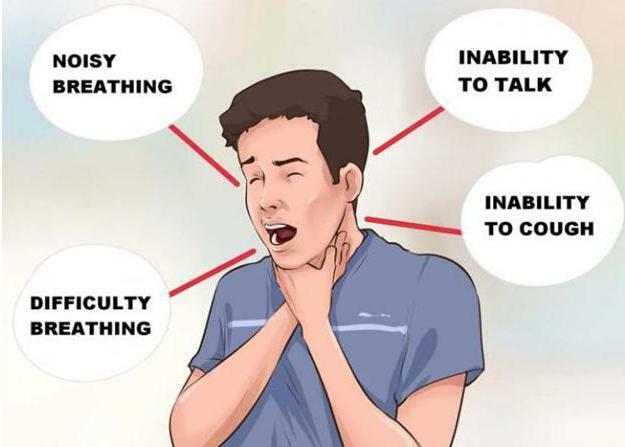
How can a foreign body get into the respiratory tract?
According to statistics, more often cases are recorded when a foreign body is found in the airway in a child. Symptoms of this state can be different, it all depends on how much the object has blocked the flow of air. But in any case, this situation is extremely dangerous for the life and health of both the child and the adult.
Therefore, it is very important not to leave children under the age of three without adult supervision - kids often try out a "find", as they say, on the palate. In addition, cutting teeth also contribute to the fact that children pull the first objects in their mouth.
In addition, babies often spin, laugh, talk while eating, which can also lead to aspiration without a chewed piece of food. And not fully developed system of reflex processes in children younger than those years contributes only to worsening the situation, significantly increasing the risk of suffocation.
But doctors regularly face situations when foreign bodies get into the airways of an adult. Conditions that increase the risk of such situations are as follows:
- alcohol intoxication;
- communication, laughter while eating;
- substandard dentures;
- unprofessional rendering of dental services( in medicine, cases of suffocation by a remote tooth, removed by a crown, broken instruments) are known.
What is the danger?
The ingress of foreign bodies into the upper respiratory tract of an adult or child is an emergency that requires emergency medical care. Although in medical practice, examples are known when the patient asked for help from doctors complaining of complicated breathing only a few months after getting a foreign object into the body. But nevertheless in most cases time for rendering assistance and saving a person is measured in seconds.
What happens in the body if the respiratory tract is a foreign body? Unfortunately, medical statistics are disappointing. So, in almost 70% of all such cases, a foreign object reaches the bronchi, less often( about 20%) - is fixed in the trachea and only 10% remain in the larynx( we'll run ahead of time and say that in the latter case, the foreign body is most easily removed from the respiratorypaths, although there are exceptions to this rule).
The human reflex mechanism works in this situation as follows: as soon as the object passes through the vocal chink, a muscle spasm occurs. Thus, even strongly coughing, it is extremely difficult for a person to remove a foreign body. Such a protective mechanism further complicates the situation and contributes to the development of suffocation.
Why do some cases do not pose a high danger to human life and health, while others are, as they are called in medicine, emergency? It is difficult to answer this question unambiguously - here the combination of different circumstances is important. Including such:
- properties of the acquired object( its size, structure, weight, shape, etc.);
- depth, which could penetrate the foreign body, the place of its fixation;
- diameter of the remaining lumen in the airways - this affects the possibility of gas exchange.
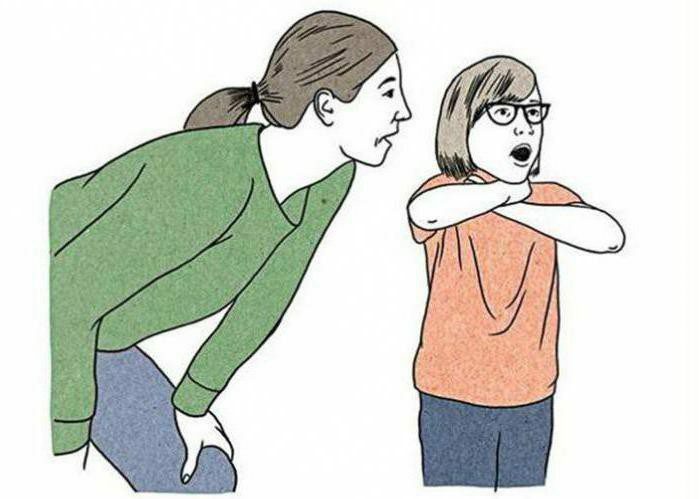
The most dangerous objects
What is the danger of getting a foreign body in the respiratory tract? The structure of an extraneous object plays a decisive role. So, the larger it is in size, the higher the probability of overlapping space for air flow. But small objects can cause serious problems. For example, even pieces of meat, sausage or boiled potatoes can provoke an attack of suffocation, if they fall into the spasms of the vocal cords.
Uneven or sharp objects can not only "catch" the walls of the trachea, but also injure it, which will lead to even greater complications.
Harmless nuts at first glance are dangerous because, after getting into the respiratory tract, they can, due to the air flow, mix from one zone to another, causing unexpected attacks of suffocation( the person did not eat anything and suddenly became choking, and this situation can be repeated many timesbefore removal of foreign body from the respiratory tract).
And here are just the items that are usually considered the most dangerous - metal, plastic or glass( often children swallow toys with exactly those characteristics, for example, balls from the rattle, small parts of the designer) - of all the listed possible foreign bodies are the least likely to cause suffocation.
It should be noted that organic vegetable foreign objects in the airways are dangerous not only for the possibility of blocking the access of oxygen, but also for other complications:
- they have the property of breaking into pieces, which can lead to numerous repeated attacks of suffocation;
- such bodies as a result of being in the "greenhouse" conditions inside the body can swell, increasing in size, thus gradually worsening the human condition;
- plant components result in the formation of inflammation in the fixation site as a result of organic processes.
Thus, if there is a foreign body in the respiratory tract, then, no matter how deeply it progressed, it should be removed as soon as possible, as the consequences can be felt at any time. 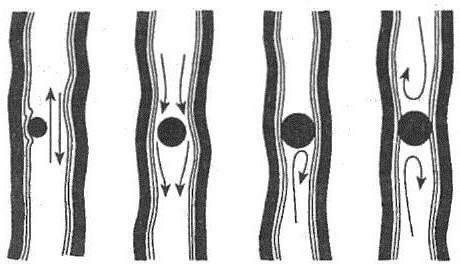
The danger of this situation is its sudden occurrence and rapid onset of suffocation. Then the effect of surprise is triggered - and the suppressed person, and others can simply become confused and begin to panic. Unfortunately, such a reaction to an emergency situation can lead to a tragic outcome. Therefore, it is important not only to remember the technique of rendering medical assistance in such cases, but also be prepared to psychologically provide this very help at the right time.
It is especially important to correctly respond when a foreign body is stuck in the airway in a child. Symptoms can be different, so it is important to recognize them in time and begin to help the baby, because here the time count goes for a second.
In order to reduce the likelihood of such situations, it is necessary to follow preventive measures, which are described in more detail in the relevant section of the article.
To help a person who suffers suffocation due to penetration of an alien object, it is extremely important to quickly "identify" the characteristic signs of such a condition. What are the symptoms of a foreign body in the respiratory tract? Read about it below.
Symptoms that indicate the ingress of a foreign body into the respiratory tract
How does one understand that a person suffers from having a foreign body in the respiratory tract? The signs of such a state are different and depend on the structure, size of the object, and also the place where it was fixed.
So, a large object that completely blocks the access of oxygen causes a sharp cough, a person instinctively grabs his hands behind his throat, after a few seconds, loss of consciousness, redness of the face, and then blueing of the skin can occur.
If, in the respiratory tract, the foreign body is fixed in such a way that there is a small gap for gas exchange, the characteristic features of this state are the following:
- convulsive cough, often accompanied by vomiting or hemoptysis;
- infringement of a rhythm of an inspiration-exhalation;
- enhanced salivation;
- appearance of tear;
- short-term episodic bouts of respiratory arrest.
This state can last up to half an hour - it is during this time that the reflex protective functions of the organism are depleted.
In the event that small smooth objects hit the person's airways, there may be a complete absence of any signs of such a condition for a certain period of time( depending on where the object was fixed, whether organic or inorganic, an alien body).But, unfortunately, if you do not take any measures to remove a foreign object from the human body, it will not "resolve" by itself, but will cause serious complications. After a certain time, the victim will have various problems with breathing, for example, such as shortness of breath, hoarseness in the voice, and others. If you listen with a stethoscope, you will hear noises in the area of fixation of the foreign body.
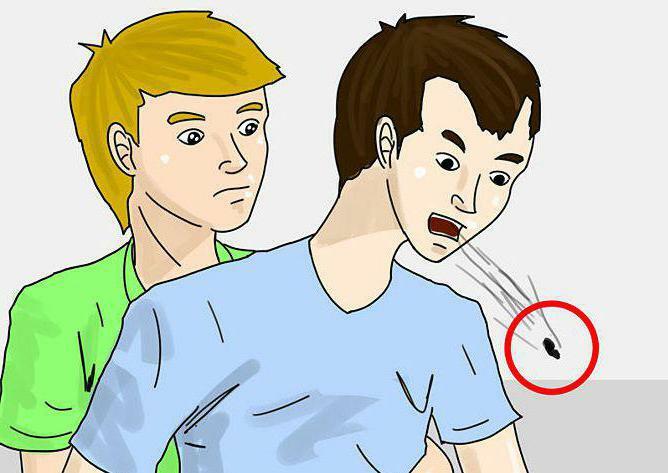
Can I help myself?
Is it possible to provide first aid for the foreign body of the respiratory tract? It's possible. But here it is important to reserve self-control and not give in to panic. Since there is very little time, it is necessary first of all to calm down and not to make sharp breaths( this only will aggravate the situation, because the airflow will simply advance the subject deeper).
The algorithm of action in such an emergency situation is as follows:
- Smoothly, slowly inhale, filling the chest with air. Then exhale as quickly as possible, trying to push the object in the throat.
- Another way to help yourself remove the foreign body from the airways - during a sharp exhalation, press the upper abdomen on the countertop or the back of the sofa.
The technique of rendering first aid in case of ingestion of a foreign body in the respiratory tract
Foreign bodies found in the respiratory tract? First aid in this situation should be provided as follows:
- Immediately call a team of doctors.
- Prior to the arrival of physicians, first aid should be provided, according to the technique described below.
Remove foreign body in two ways:
1. Bend the victim through the back of an armchair, chair or thigh of the person who is helping. Then open the palm sharply hit between the blades 4-5 times. If the victim has lost consciousness, then he should be laid on his side and hit on the back. This method is called in the medical literature by the Mofenson method.
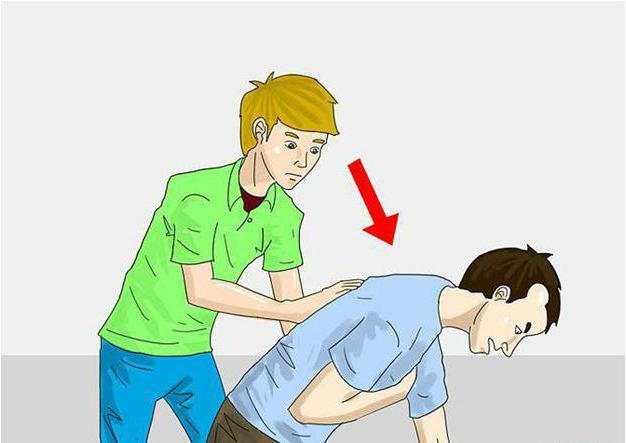
2. Another way is the following: it is necessary to become behind the suffocating, to clasp his hands under the ribs and to make sharp compressions in the direction from below-upwards. This is the so-called Heimlich method.
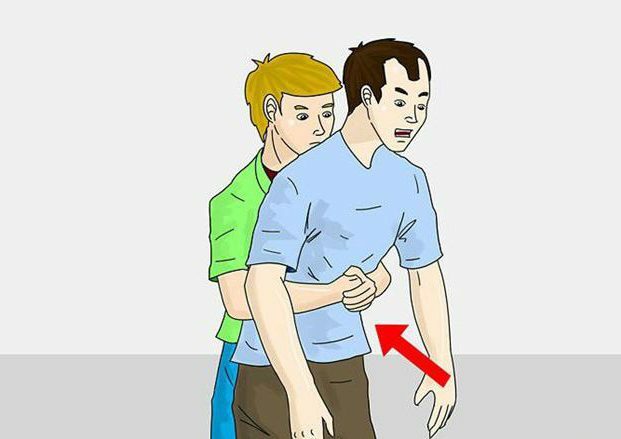
If the above described methods do not work and the patient's condition worsens, you can resort to such a technique of providing medical assistance: lay the patient on the floor, placing a roller under the neck so that the head hangs downwards. It is required to prepare a napkin, a cloth flap or something like that. Then you need to open the mouth of the victim. Using the material, you need to grab the human tongue and pull it to yourself and down - perhaps, so the foreign body becomes noticeable, and it can be pulled out with your fingers. However, it is not recommended to perform such actions to a layman, since the technique requires special skills. And with improper assistance, you can further damage the victim.
Signs of foreign body aspiration
Adult people can accurately understand and characterize their condition in the event of such a situation. But children sometimes even forget that they accidentally swallowed a wheel from a toy car or a part of a designer. If an aspiration of a large object that blocked access to air occurs, the symptoms will be the same as described above: convulsive coughing, vomiting, redness of the face, and then cyanosis of the skin.
But in case the foreign body penetrated deeply, the signs of such a state may be completely absent. In order to determine the presence of foreign matter in the respiratory tract of the crumbs, you need to ask him to talk with an adult. If a child pronounces his words with difficulty, hears whistling or "clapping" sounds, the child has a timbre or a voice - the baby needs urgent medical help.
Foreign bodies of the respiratory tract in children: first aid
The technique of first aid to children differs from the "adult version."This is due to the anatomical features of the structure of the growing body. How can a child help if there is a suspicion of such pathology as foreign bodies of the upper respiratory tract? The first help in this situation is as follows:
- If the child is less than a year old, then it must be placed on the forearm in such a way that the adult can hold the chin of the crumb with his fingers. The head of the baby should hang down. If the child is older than the specified age - he is laid on his knee.
- Then you need to knock 4-5 times with your palms open between the baby's blades. The younger the child, the weaker the blows.
- If the indicated technique has not given results, it is necessary to lay crumbs on the back and produce so-called subdiaphragm jerks. In this case, two fingers( if the child is less than a year old) or a fist( for children older than a year) should be placed on the abdomen just above the navel and perform sharp pressing movements inward and upward.
- If there is no improvement in the condition of a small patient, you should begin carrying out resuscitation( artificial respiration) before the arrival of the "first aid".
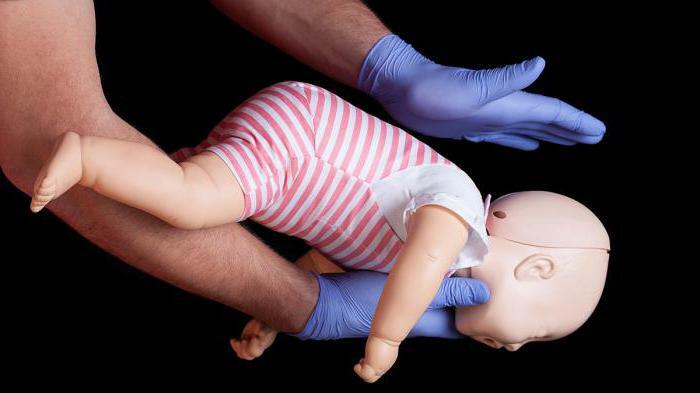
Surgical methods for removal of a foreign body from the respiratory tract of a person
What can be done if the foreign body was not removed by the above described methods? Then, most likely, you will need surgical intervention. In order to determine what kind of surgery is needed in a particular case, specialists conduct such studies as diagnostic laryngoscopy and fluoroscopy. Depending on the results, the doctor can prescribe the following manipulations:
- Laryngoscopy. With this procedure, not only determine the presence of a foreign body in the larynx, trachea and vocal cords, but also remove it.
- Upper tracheobronchoscopy using forceps. This procedure involves the introduction through the mouth cavity of the endoscope, through which a special instrument is delivered, capable of removing the foreign body.
- Tracheotomy is the surgical formation of an external opening in the trachea.
All described methods are dangerous for the development of complications both during their conduct and during the postoperative period. 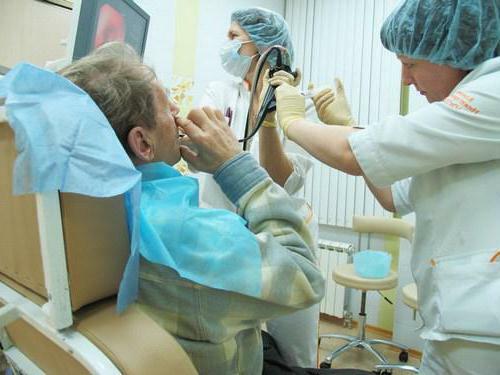
Preventive measures
The diagnosis of "foreign bodies of the upper respiratory tract" is extremely dangerous and requires urgent medical attention. In order to reduce the likelihood of such an emergency, you should follow simple recommendations:
- During meals, do not talk, turn around, watch TV.Children should also be accustomed to such rules of behavior at the table.
- Do not abuse alcohol.
- Promptly seek medical help in the presence of oral diseases( including dental).
- Keep potentially dangerous items out of the reach of children.
This material provides recommendations on how to remove foreign bodies in the airways. First aid for both the adult and the child should be provided as soon as possible, in some situations there is simply no time to wait for the doctors. Therefore, the information presented in this article can be important and necessary for everyone.
